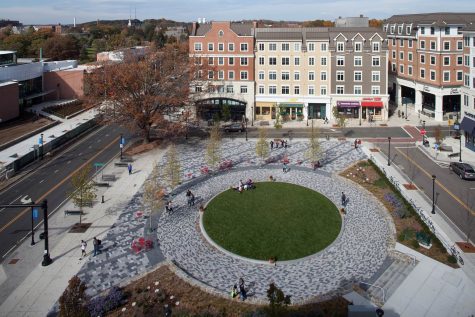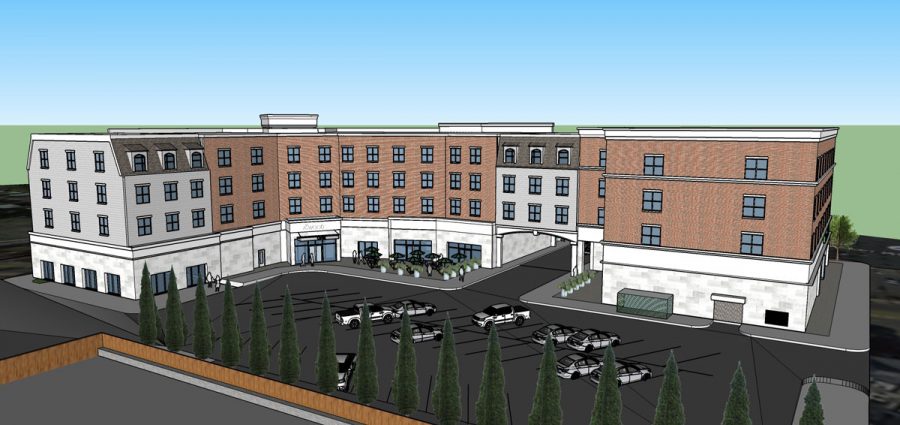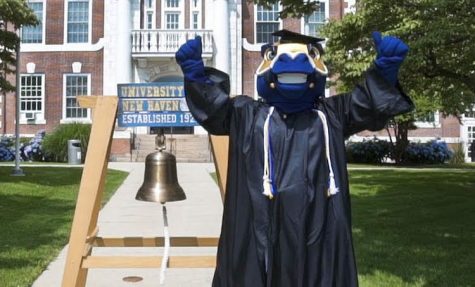West Haven, UNH Hope for Ripple Effect Around New Housing
The new Atwood is projected to cost more than Celentano Hall, UNH’s most expensive residence Hall.
Two years ago, people driving past CVS on Boston Post Road as they left the University of New Haven would be greeted by an abandoned warehouse, filled with cracked windows and a mysterious history. Today, the same space is occupied by a different project, but instead of being on the verge of collapse, it is being built up to a new standard as a luxury apartment building.
The Atwood stands in an area beaten down in the modern era. Across the street is a tiny strip mall with no aesthetic appeal, hosting a small liquor store, a fish n’ chips eatery and a sports bar. Directly surrounding the new complex is a CVS popular to U.N.H. students, despite its worn-out exterior. On the other side, a small grocery store looks on with the same depleted feeling as the rest of the neighborhood.
“The area has a lot of development possibility,” says George Synodi, Vice President for Finance and Administration at U.N.H.
The University is looking to make this property a hub for their students, possibly even leasing out the property with the help of thepropertybuyingcompany, if there is enough student interest, according to President Steven Kaplan.
Synodi says that this initiative is to hopefully house more students closer to campus, instead of having them diverted off campus in their junior and senior year. A study done by the University using an outside firm a few years ago recorded that there was a demand for a space of about 15-20 thousand square feet.
There is a three part plan to put up buildings around the crossroads by Campbell and Forest Avenue. First is the Atwood, which is set to open its doors in May of 2017. The next two buildings are scheduled to follow in construction across the street with a scheduled opening in 2019.
Doubts about the possibility of success have been floated around by students and community members. Being a luxury apartment complex, the price of rent could be out of range for a lot of students.
Synodi doesn’t know exact numbers for pricing yet, but estimates it will be roughly the same cost as a room in Celentano per month, with a 12-month lease. This would mean that students would pay equal or less per month for a Celentano single room – the most expensive room on campus – but would be paying for 12 months of occupancy rather than eight. These prices would make the total cost per year higher than anything on campus.
Many students leave on-campus housing in their upperclassmen years to save money. Sophomore Karina Krul is looking to do the same if she can.
“I won’t go off campus if it costs more than on campus housing once everything is said and done,” she said. She also noted that she would live in off-campus housing if it was roughly the same cost as Celentano.
Synodi recognizes that the price could turn students away, but hopes they see the value in living in a nicer apartment.
He also cited the results from the initial opening of Westside Hall in 2014, which is also close to the price of Celentano. More students than the building could hold signed up as interested and willing to pay the extra fee to live in a building with more amenities.
“No one knows how long it will take,” Synodi says about the up-risk for the property. Up-risk is the chance associated with filling up all the rooms in a residential property.
The university plans to look at the fallout of the first building and then decide what to do about the other two.
The city of West Haven is looking to actively regenerate the area, citing that there is a lot of possibility to bring new life with the new apartment structures.
“There’s a lot of excitement in the city about seeing it go there,” said David Killeen, Assistant City Planner for West Haven.
The development, including the recently concluded roadwork at the intersection of Campbell Ave. and Boston Post Rd., is an ongoing effort to make the area a more “pedestrian-friendly environment,” according to the city.
The Atwood’s 67 units will house students and residents of West Haven alike, with no clear indication of whether or not the building will be worked into the U.N.H. housing lottery. The apartments are deemed “luxury” since they are equipped with a washer and dryer, walk-in closets, a high-end finished look, as well as other amenities.
The bottom floor of The Atwood and the two buildings to follow will each be occupied on the first floor by commercial real estate, generally catered to the college student community. According to Killeen, several businesses have expressed interest in the area as a whole, and Synodi added that there are retail tenants that are willing to move in. There are no confirmations yet, but he indicated that applicants were being screened based on their relevance and appeal to the University.
Plans for the design and construction came from a similar project done at the University of Connecticut in Storrs, using the same first floor commercial plans in each residential building. A much larger endeavor, the five to six phases (compared to West Haven’s three) created a small community just across the street from campus.
Some commercial tenants include Insomnia Cookies, Moe’s Southwest Grill, and other independent stores. There was a delay with the filling up of these residencies, as with any, but Synodi believes that the property in West Haven will achieve the same success.
U.N.H. is looking to expand more into the area down by CVS and through Charger Plaza, in which Synodi says is a “natural extension.” The university is eyeing Charger Plaza for some type of usable expansion, possibly even moving the bookstore to that location, President Kaplan told USGA last month.

Glenn Rohrbacker is a junior at the University of New Haven studying communications with a concentration in journalism and minors in Political Science...








